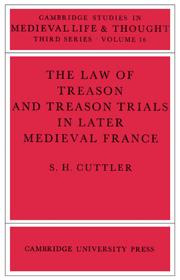Book contents
- Frontmatter
- Contents
- Dedication
- Preface
- Abbreviations
- Introduction
- 1 THE CONCEPT OF TREASON IN LATER MEDIEVAL FRANCE: LEGISTS, ‘COUTUMIERS’ AND TREATISE-WRITERS
- 2 THE CRIMES OF TREASON
- 3 JURISDICTION
- 4 PROCEDURE AND THE TRIAL OF PEERS
- 5 PUNISHMENT, FORFEITURE AND PARDON
- 6 TREASON AND THE CROWN 1328–1356
- 7 TREASON AND THE CROWN 1356–1380
- 8 TREASON AND THE CROWN 1380–1422
- 9 TREASON AND THE CROWN 1422–1461
- 10 TREASON AND THE CROWN 1461–1494
- Conclusion
- Bibliography
- Index
5 - PUNISHMENT, FORFEITURE AND PARDON
Published online by Cambridge University Press: 13 October 2009
- Frontmatter
- Contents
- Dedication
- Preface
- Abbreviations
- Introduction
- 1 THE CONCEPT OF TREASON IN LATER MEDIEVAL FRANCE: LEGISTS, ‘COUTUMIERS’ AND TREATISE-WRITERS
- 2 THE CRIMES OF TREASON
- 3 JURISDICTION
- 4 PROCEDURE AND THE TRIAL OF PEERS
- 5 PUNISHMENT, FORFEITURE AND PARDON
- 6 TREASON AND THE CROWN 1328–1356
- 7 TREASON AND THE CROWN 1356–1380
- 8 TREASON AND THE CROWN 1380–1422
- 9 TREASON AND THE CROWN 1422–1461
- 10 TREASON AND THE CROWN 1461–1494
- Conclusion
- Bibliography
- Index
Summary
In 1610, for having assassinated Henri IV, François Ravaillac was condemned by the Parlement of Paris to a most horrible death.
His breasts, arms [and] thighs…were plucked by red-hot pincers, his right hand that held the knife [was] burned by sulphur-fire, and on the places where he [was] plucked by the pincers, molten lead, boiling oil, burning pitch, and molten wax and sulphur were poured. This done, his body was dismembered by four horses, [and] his limbs and corpse [were then] consumed by fire, reduced to ashes [and] thrown to the wind.
In later medieval France there was no punishment for treason that matched this in cruelty, but the penalties inflicted on traitors were often not much less severe.
Decapitation and/or hanging were not uncommon, but as in England a traitor's death could be clearly distinguished from that of other felons by the additional penalties of drawing and/or quartering. The execution in 1323 of Jourdain de l'lsle-Jourdain, lord of Casaubon, who was stripped naked, drawn on a hurdle from the Châtelet to the gibbet, and hanged there, left a vivid impression on a contemporary chronicler. ‘One cannot remember nor can one find it written in the gestes of France,’ he remarked, ‘that a man as highborn as my lord Jourdain has ever suffered such a death since the time of Ganelon.’ Another example confirms that drawing was a hallmark of the punishment for treason. In April 1328 Pierre Remi, chief treasurer of the late Charles IV, was sentenced to be hanged for maladministration. Just as he was about to be executed he admitted ‘that he had committed treason against the king and the kingdom in Gascony’.
- Type
- Chapter
- Information
- The Law of Treason and Treason Trials in Later Medieval France , pp. 116 - 141Publisher: Cambridge University PressPrint publication year: 1982



